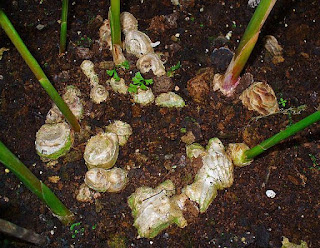INTRODUCTION
Ginger is one of the World’s most well known plants, have been used for centuries as a spice to savour food and for its medicinal properties. Ginger is a herb, Perennial flowering plant. Ginger used as a spice to flavour food and as a medicine.
The spice Ginger is a Rhizome, which is a horizontal stem from which the roots grow in the Ginger plant. Rhizome is the main portion of the Ginger plant, which is an edible part of the plant. The root is comprised of essential oils and resins which is responsible for its odour and spicy savour. Ginger has aromatic, pungent and hot taste.
Ginger referred as Asia’s most treasured spice. The name Ginger derived from the Sanskrit word ‘Shringavera’ meaning “shaped like a Deer’s antlers (horns)”. In Greek it was referred as ‘ziggiberis’ and in Latin, called as ‘zinziberi’. In many Asian foods Ginger used because of its Spicy savour.
 |
| GINGER |
Image Source : Wikimedia Commons
Ginger is native to South Eastern Asia, particularly to Southern India and China. Indians and Chinese believed to have used Ginger as a tonic to cure many ailments for over millennia. Ginger celebrated in many areas throughout the world for many years.
Binomial / Scientific Name : Zingiber officinale
Family : Zingiberaceae
Ginger family includes Turmeric, Cardamom and Galangal.
Ginger is highly valued for its savour as well as for its Therapeutic uses throughout in Asia. Ginger is most popular for its easeful effect on the stomach; it is widely used to cure stomach ailments like nausea, vomiting, constipation problems from earlier days to present.
HISTORY
Ginger consumed as raw as well as in powdered form. The benefits of ginger known to the world for many thousands for years, i.e., approximately 4500 – 5000 years back. Chinese, Indian and Arab used ginger in their medicines to cure various ailments. From India and China, the cultivation of ginger crop spread to other countries.
Chinese used Ginger at least in the sixth century BC. ‘Sheng jiang’- Medical book in China has discussed about the Ginger root for medical uses in 2000BC. Confucius– Ancient Chinese Philosopher admired Ginger for its medicinal benefits.
Ginger has been mentioned in ‘Mahabharata’- 4th century BC one of the two significant Sanskrit epics of Ancient India. Ginger is one of the notable plants in the Ayurvedic medicines, native to the India. Ginger’s medicinal treatments recommended in ‘Charka Samhita’ and the ‘Sushruta Samhita’ an Ayurvedic texts.
Before 1st Century AD, the Arab Traders spread Ginger from Asia to the Mediterranean region.
In the 1st Century, Europeans saw the ginger for the first time when the Ancient Romans traded with India. Ginger was an extremely significant article in trade between India and Rome. They valued Ginger for its Medicinal and culinary properties. With the fall of Roman Empire, the use of Ginger also declined. Then Marco Polo brought Ginger back to the country. After the fall of Roman Empire, Arab Traders controlled the trade. They sold Ginger and other spices for centuries in the European markets.
In the Middle Ages i.e. 13th or 14th or 15th or 16th centuries, the cost of half a kilogram or one pound of Ginger was equivalent to the cost of one sheep.
The Greeks made Gingerbread men, Gingersnaps, cakes and Biscuits.
 |
| GINGER SNAP |
Image Source : Wikimedia Commons
Image Source : Wikimedia CommonsGINGERBREAD MEN
The Arab travellers planted Ginger on their way to Africa and Zanzibar and thus Ginger got its expansion in the African continent.
The gingerbread man cookie was a famous Christmas treat, created by Queen Elizabeth I of England, since her father Henry VIII recommended gingerbread as a remedy for Plague.
In the 16th Century, Spanish conquerors introduced Ginger into the New World and soon in Jamaica and in Brazil and they started to export.
GROWTH OF GINGER
CLIMATE AND SEA LEVEL : Ginger is a Tropical plant. It requires warm and humid climate for cultivation. Ginger can be cultivated under rain fed and irrigated fields. Ginger can be cultivated in various degree of altitude. The elevation above 1500m mean sea level is suitable for its growth. It can grow at an altitude of 300m to 900m.
Moderate rainfall is required when sowing until the Rhizome sprouts. Before a month of harvesting period, it requires dry weather with a temperature between 28°C to 35°C.
SOIL AND RAINFALL : Ginger cultivated best in the rich soils like sandy loam, clay loam, or laterite loam which are rich in humus and in shady places. Alluvial gravel mixed Red soils also used for cultivation. Soil pH ranges from 6 to 6.5. Ginger requires rainfall of 1500mm to 3000mm at regular intervals per year. Ginger not farmed repeatedly in the same field.
Image Source : Wikimedia CommonsGINGER PLANT
GINGER FLOWER
Image Source : Wikimedia Commons
HARVEST : The Ginger used for cooking purpose is harvested from the 5th month after sowing. This immature Ginger has less alkalinity and fiber. This Ginger called as ‘Green Ginger’.
Harvesting between 8 to 9 months (245 -260 days) from the date of sowing called as ‘Dry Ginger’. By this time the leaves turns yellow and progressively dries up. Ginger (Rhizome) is unearthed carefully, soil is removed, the outer skin is peeled, washed with water and it is made to dry in shady places for one week. This is ‘unbleached Ginger’.
The peeled, cleaned Rhizomes are soaked in 2% of limewater for 6hours and made to dry in shade. This Ginger called as ‘Bleached Ginger’. ‘Black Ginger’ created by steaming the Rhizome and making it dry.
VARIETIESIndia considered as the largest producer of Ginger in the world. Southwest and Northeast India are most flexible for Ginger cultivation because of its warm and humid climate. There are 100’s of different varieties of Ginger and it originated Asia in the parts of hot and humid places. Ginger planted in our home as well. The Indian Varieties are :
- Indian Institute of Spices Research, which is located in Kozhikode – 673 012, Kerala cultivates
- IISR Varada
- IISR Mahima
- IISR Rejatha
- High Altitude Research Station and the Orissa University of Agriculture and Technology, which is located in Pottangi – 764 039, Orissa cultivates
- Suprabha
- Suruchi
- Suravi
- Subhada
- Y.S. Parmar University of Horticulture and Forestry, which is located in Nauni, Solan, Himachal Pradesh – 173 230 cultivates
- Himagiri
- Kerala Agricultural University, which is located in Thrissur – 680 656, Kerala cultivates
- Athira
- Karthika
- Aswathy
These are improved varieties of Ginger.
> Many cultivators of Ginger grow ginger in different areas in India and they named after the localities. Some of the indigenous cultivars are:
- Maran
- Kuruppampadi
- Ernad
- Wynad
- Valluvanad
- Mannathody
- Himachal
- Naida
The other varieties are : Assam, Rio-de-Janeiro, China
Jamaican Ginger is light yellowish brown in colour and has a very good aroma. African Ginger is dark in colour and it has light aroma. Jamaican Ginger is more pungent than African Ginger.
Cochin and Calicut Gingers considered as best Gingers. They are strong aromatic, pungent with lemon flavour.
Chinese Ginger’s are white in colour and used in the preserved form.
NUTRITIONAL ANALYSIS
Fresh Ginger comprised of Magnesium and Potassium. Dried Ginger contains calcium, potassium, phosphorus, magnesium, sodium, niacin, vitamin A and manganese. Raw Ginger comprises 79% of water.
There are at least constituents are identified in fresh and dried Gingers varieties. Gingerols are the major constituents of fresh ginger and it slightly low in dried Ginger. Shogaols are more abundant in dry ginger than in fresh ginger.
Ginger is composed of 6-8% lipids - glycerides, fatty acids, phosphatidic acid, lecithin and volatile oils 1-3% - gingerol, shogaol, zingiberene, and zingiberol.
Ginger has an essential oil which is pale yellow in colour, ranges from 1% - 4% depending on its variety. This oil gives Ginger its fragrance.
The main constituents found in Ginger that gives aroma to it are zingiberene (70%), curcumene, α-pinene, sabinene, limonene, borneol, linalool, farnesene and citral.
The pungent aroma of Ginger is due to its gingerol, shogaol, zingerone and paradol components. These are powerful anti-oxidants as well as anti-inflammatory and anti-microbial agents.
‘Zingerone’ formed during drying from Gingerols. It has low pungency and sweet smell. ‘Shogaols’ has more anti-oxidant property, very pungent and found in dry ginger. Shogaols formed from Gingerols during heating, storage or via acidity. ‘Zingibain’ is an enzyme found in fresh ginger.
 |
| GINGER POWDER |
Nutitioal value per 100g :
- Energy : 333kJ (80kcal)
- Carbohydrates : 17.77g
- Sugars : 1.7g
- Dietry Fiber : 2g
- Fat : 0.75g
- Protein : 1.82g
Vitamins Quantity
- Thiamine (B1) 0.025mg
- Riboflavin (B2) 0.034mg
- Niacin (B3) 0.75mg
- Pantothenic Acid (B5) 0.203mg
- Vitamin B6 0.16mg
- Folate (B9) 11μg
- Vitamin C 5mg
- Vitamin E 0.26mg
Minerals Quantity
- Calcium 16mg
- Iron 0.6mg
- Magnesium 43mg
- Manganese 0.229mg
- Phosphorus 34mg
- Potassium 415mg
- Sodium 13mg
- Zinc 0.34mg
CONCLUSION
Ginger known for its many uses besides culinary it plays a vital role as medicine too. Ginger is rich in many nutrients. It cures various ailments. Consuming ginger in right proportion heals many ailments.
CLICK HERE FOR : BENEFITS






No comments: